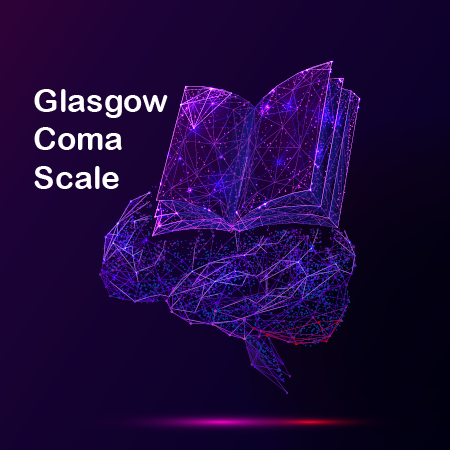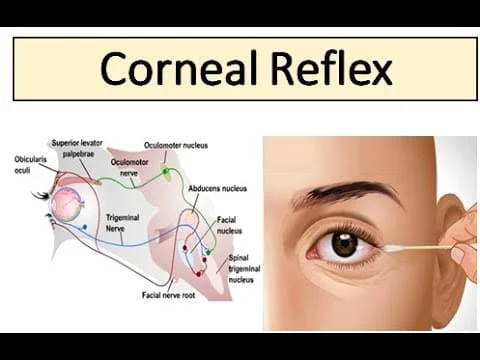Glasgow Coma Scale
Table of Contents
Introduction
A Clinical scale called the Glasgow Coma Scale (GCS) is used to accurately assess a patient’s level of consciousness following a brain injury.
A person is evaluated by the GCS based on their capacity for speaking, moving their body, and making eye motions. The visual, verbal, and motor behaviours comprise the three elements of the scale. The GCS score of an individual can vary from 3 (totally unresponsive) to 15 (responsive). This score is used to monitor hospitalized patients and measure their degree of awareness, as well as to provide rapid medical care following a brain injury (e.g., from an automobile accident).
A higher risk of death is connected with lower GCS scores. However, it’s not appropriate to use the GCS score by itself to forecast a person’s prognosis if they have brain damage.
What is a Glasgow coma scale (GCS)?
A method for “scoring” or quantifying consciousness is the Glasgow Coma Scale (GCS). It accomplishes this by assigning numerical values to your degree of consciousness, degree of waking, and ability to follow simple commands.
In 1974, researchers at Glasgow University in Scotland created the GCS. Even though the word “coma” is in the name, the GCS is now far more often used in medicine. It is the scale that is most frequently used to assess consciousness alterations, including comas.
Healthcare professionals use the Glasgow Coma Scale as a tool to measure reductions in awareness. In addition to helping clinicians monitor changes, the scores from each section of the scale are helpful in characterizing disturbances in nervous system function. It is the most popular instrument for quantifying comas and awareness declines.
The Glasgow Coma Scale rates your ability to move, see, and speak in order to gauge your level of consciousness.
Based on your eye, speech, and movement responses, medical professionals can assess your level of consciousness—or how deeply in a coma you are—using the Glasgow Coma Scale.
History
In 1974, Graham Teasdale and Bryan Jennett created the Glasgow Coma Scale (GCS). The “depth and duration of impaired consciousness and coma” that a patient experiences after an acute brain injury is measured using a clinical scale.
A basic chart can be used by medical professionals to track a patient’s eye-opening, verbal performance, and motor responsiveness. With 30 language translations, the GCS is the most widely used assessment instrument in the world. It is not to be confused with the Glasgow Outcome Scale (GOS), which assesses the degree of ongoing disability following a brain injury.
The Glasgow Coma Scale was first created to assist in assessing the degree of dysfunction or coma after a traumatic brain injury; however, it can be helpful for any illness that impairs consciousness.
It is regularly used for a variety of ailments these days, such as:
- Stroke (Classification of stroke: Subarachnoid hemorrhage, Intracerebral haemorrhage, or Ischemic stroke)
- Infection
- Seizures
- Brain abscess
- General traumas and ITU patients
- Non-traumatic coma
- Overdose
- Poisoning
It can also be used to track changes and patterns in patient consciousness over time in a range of contexts, including pre-hospital, when the patient arrives at the emergency room, and in the hours after admission.
Scales that have been altered have been created for usage with various populations. An amnesia scale is part of the Glasgow Coma Scale Extended (GCS-E), which helps patients with mild traumatic brain injury stay in treatment longer by preventing their early discharge. Additionally, scales that have been adjusted for use with the pediatric population have been produced.
When assessing older children and preverbal children, the motor scale has shown to be the most beneficial when examining blunt trauma. Studies have shown that the motor scale by itself can streamline the evaluation procedure while maintaining the accuracy of the score.
What is Consciousness?
There are three prerequisites for consciousness in the medical domain. To be conscious, an individual needs to be:
- Awake: This refers to your capacity to awaken in response to sound or touch. That is the distinguishing factor between a coma and simple sleep.
- Alert: This measures your ability to understand what’s going on in your immediate environment and your receptivity to those speaking to you.
- Oriented: This indicates that you are aware of your identity, location, day, and other current information.
When is the Glasgow Coma Scale utilized?
The GCS is a tool that medical professionals can use in a neurological examination. It’s also helpful in any circumstance where you might become less conscious. This includes ailments linked to injuries such as traumatic brain injuries and concussions.
In addition to injuries, the scale can be useful in treating non-injury-related disorders like hypoglycemia, poisoning, and seizures.
What is measured by the Glasgow Coma Scale?
A neurological examination searches for any issues with the two main components of your nervous system’s operation. Those sections belong to you:
Central nervous system: The brain, brainstem, optic nerves (which connect your brain to the retinas in the back of your eyes), and spinal cord make up your central nervous system.
Peripheral nervous system: All of the nerves that are not part of your central nervous system are called the peripheral nervous system.
Three categories on the Glasgow Coma Scale relate to a neurological examination. The majority of them deal with your brain directly; however, some may also affect your spinal cord and other body nerves:
- Eye response: This indicates your level of awareness and vigilance.
- Motor response: This section deals with your brain’s capacity to regulate muscular contraction. Additionally, it can reveal any problems with the connections that your brain has with the rest of your body.
- Verbal response: This assesses your capacity for thought, memory, focus, and environmental awareness, among other mental functions.
What is the Glasgow Coma Scale’s methodology?
Providers combine the scores from the three GCS categories to determine your Glasgow Coma Scale score. Each of the three areas will be tested in various ways by a healthcare professional. To evaluate your vocal response, for instance, you could be asked a series of questions like what day of the week, what day it is, or the location you are now in.
Monitoring your level of consciousness changes is one of the best uses for the GCS. A neurological exam will frequently be repeated at regular intervals by healthcare professionals to monitor and record any changes in your GCS score.
The following are the categories’ scoring guidelines:
Eye response
The essential thing here is your level of awareness. It assesses your degree of unconsciousness by measuring your reflex reactions to pressure if you are not conscious. In this context, pressure refers to a pinch or a poke. It needs to be just enough to inflict brief, mild discomfort but not harm.
Eye response score: Score meaning
- 4: A person can open their eyes and keep them open on their own.
- 3: A person only opens their eyes when someone tells them to do so. The eyes stay closed otherwise.
- 2: A person’s eyes only open in response to feeling pressure.
- 1: A person’s eyes don’t open for any reason.
Verbal response
To verify this, a healthcare provider will ask you questions that assess your recall, critical thinking, and environmental awareness. This can also be used by your doctor to check for brain or nerve issues that could be impairing your ability to control your mouth and face.
Verbal response score: Score meaning
- 5: You are oriented. You can accurately respond to inquiries regarding your identity, location, day of the week, etc.
- 4:You are confused. Although you can respond to inquiries, it appears that you are not quite conscious of what is going on.
- 3: You can converse and be understood by others, yet your answers to inquiries are illogical.
- 2: You are limited to making noises and are unable to speak.
- 1: You are mute and unable to talk.
Motor response:
Any problems with the connections between your nerves, spinal cord, and brain can be found in this section. It also assesses your ability to comprehend and adhere to instructions, as well as your brain’s capacity to regulate muscle movement.
Score for motor (movement) response: Meaning of a score
- 6: You adhere to guidelines regarding when and how to move.
- 5: You consciously turn away from something that is pressing against you.
- 4: Reflexively, you only move away from anything that is pressing against you.
- 3:Your muscles flex, or draw inward, in reaction to pressure.
- 2:In reaction to pressure, your muscles lengthen (stretch outward).
- 1:You don’t react to pressure by moving.
The most popular methods for evaluating a person’s reaction to pain are as follows:
- Pressing on one of the patient’s fingertips
- Applying pressure on a patient’s trapezius muscle (sometimes referred to as a trapezius squeeze)
- Putting pressure on the supraorbital notch of the patient
- If the patient opens their eyes in reaction to a painful stimulation, they get a score of 2.
Pediatric scoring
Younger children have difficulty with the tests required to determine a child’s Glasgow Coma Scale status. Consequently, a version for children has been created and is described below.
Pediatric Glasgow Coma Scale:
NT: Not testable
- Eye Examination:
NT: severe trauma to the eyes
1. Does not open eyes
2. Opens eyes in response to pain
3. Opens eyes in response to sound
4. Opens eyes spontaneously
5. N/A
6. N/A
- Verbal Examination:
NT: Intubation
1. Makes no sounds
2. Moans in response to pain
3. Cries in response to pain
4. Irritable/Crying
5. Coos/Babbles
6. N/A
- Motor Examination:
NT: Paralysis
1. Makes no movements
2. Extension to painful stimuli (decerebrate response)
3. Abnormal flexion to painful stimuli (decorticate response)
4. Withdraws from pain
5. Withdraws from touch
6. Moves spontaneously and purposefully
Interpretation:
Individuals who score between three and eight are typically thought to be unconscious. In general, brain damage is categorized as:
- Severe: 3-8 These patients exhibit obtundation to comatose states, demonstrating an inability to obey instructions. (They might display celebratory or demure postures.)
- Moderate: 9–12 (Upon assessment, these patients can open their eyes and pinpoint unpleasant stimuli, but they are usually tired or overwhelmed.)
- Minor: 13-15 (These patients can appear confused, yet they are awake and able to follow instructions and speak.)
FAQs
The GCS is rated from 3 to 15, with 3 representing the lowest score and 15 the highest. The best verbal response (V), best motor reaction (M), and best eye response (E) make up its three parameters. Each of the GCS’s components should be noted separately; for example, E2V3M4 yields a GCS score of 9.
A GCS of 3 indicates that there was essentially no brain activity at all. It’s evident that recovery is almost always achievable because 13% of patients who had no function at all were able to recover well.
A coma manifests as one of three basic symptoms:
Being unaware: It’s impossible to wake you up from this deep sleep.
Absence of reaction from the eyes: This implies that you maintain your closed eyes and do not respond when someone holds them open.
Absence of responsiveness to movement (motor): This indicates that you don’t move intentionally.
Three locations are used by the GCS for stimulation. This comprises the supraorbital notch, trapezius squeeze, and fingertip pressure. Healthcare professionals should look for one of two responses when stimulating these areas: an aberrant flexion response or a normal flexion response.
Three distinct components are measured by the GCS: verbal responses (V), motor responses (M), and eye opening (E). The individual is categorized as mild (score = 13–15), moderate (score = 9–12), severe (score = 3–8), or vegetative state based on the sum of their individual scores (i.e., E + V + M).






2 Comments